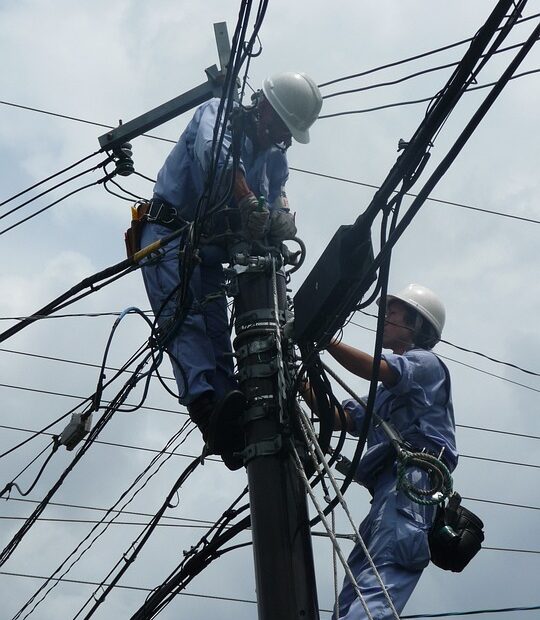Working near overhead power lines can be extremely dangerous if proper precautions are not taken. High-voltage electricity can travel through the air and cause serious injury or even death if someone comes into contact with it. Fortunately, the Occupational Safety and Health Administration (OSHA) has established regulations for working near overhead power lines to ensure worker safety. These regulations are in place to prevent accidents and injuries that can occur when working in close proximity to power lines. In this blog, we will discuss the hazards associated with working near powerlines and the regulations that must be followed to ensure everyone’s safety.
Hazards
Electrical shock is one of the most significant hazards of working near power lines. Electrical shock can occur when an individual comes into contact with a live power line or a conductor that is in contact with a live power line. The shock can be severe enough to cause burns, internal injuries, and even death. Additionally, electrical shock can cause muscle contractions that can result in falls from heights or injuries from being thrown off equipment. Some additional hazards of working near overhead power lines include the following:
- Electrocution – The most significant hazard of working near overhead power lines is electrocution. Overhead power lines carry high voltages that can cause electric shock, leading to severe injury or death. Workers must maintain a safe distance and use appropriate safety equipment when working near overhead power lines.
- Arc Flash – Another potential hazard is arc flash. An arc flash is a sudden, explosive release of energy that can occur when a fault develops in electrical equipment. It can cause severe burns, hearing damage, and even death. Workers need to be aware of the risks and take appropriate safety measures, including wearing protective clothing and using insulated tools.
- Falling Objects – Working near overhead power lines can also increase the risk of falling objects. Workers must be careful when working with equipment and materials that can fall onto the power lines, leading to a short circuit and electric shock. Workers need to use appropriate equipment and follow safe work practices to prevent such incidents.
- Contact with Vehicles – Vehicles are also a potential hazard when working near overhead power lines. Workers operating vehicles, such as cranes or cherry pickers near power lines, must maintain a safe distance to prevent accidental contact. Workers should also use insulated gloves and other protective equipment to prevent electric shock.
- Environmental Factors – Environmental factors, such as weather conditions and natural disasters, can also increase the risk of hazards when working near overhead power lines. High winds, heavy rain, and lightning strikes can cause power lines to sway or fall, increasing the risk of contact. Workers must be aware of the risks and take appropriate safety measures to prevent accidents.
Preventing Hazards
To prevent hazards when working near power lines, it is important to take safety precautions and follow safety procedures. The following are some measures that can be taken to prevent hazards when working near powerlines:
- Identify the hazards – Before beginning work near power lines, it is important to identify all potential hazards. This includes identifying the voltage of the power lines, the location of the power lines, and any conductors or equipment that may be in contact with the power lines. Additionally, it is important to assess the work area for potential hazards such as uneven ground, overhead obstacles, and nearby structures.
- Develop a safety plan – Once the hazards have been identified, a safety plan should be developed. The safety plan should include procedures for working safely near power lines, as well as emergency procedures in case of an accident or injury. The safety plan should be communicated to all workers and reviewed regularly to ensure everyone is aware of the procedures.
- Provide training – All workers who will be working near power lines should receive training on how to work safely. This should include training on identifying hazards, using equipment safely, and emergency procedures. Workers should also be trained on how to recognize the signs of electrical shock and what to do in case of an accident.
- Use appropriate equipment – When working near power lines, it is important to use appropriate equipment. This includes insulated tools and equipment, as well as personal protective equipment such as rubber gloves, safety glasses, and hard hats. Additionally, all equipment should be properly maintained and inspected regularly to ensure it is in good working condition.
- Maintain a safe distance – It is important to maintain a safe distance from power lines when working near them. The safe distance will depend on the voltage of the power lines and the type of work being performed. As a general rule, workers should stay at least 10 feet away from powerlines with voltages up to 50 kV. For powerlines with voltages greater than 50 kV, workers should maintain a greater distance. Additionally, workers should avoid placing equipment or materials outside the safe distance zone.
- Communicate with others – When working near power lines, it is important to communicate with others who may be in the area. This includes other workers, as well as members of the public. Workers should be aware of the location of powerlines and should use caution when operating equipment or moving materials near them.
Conclusion
Working near overhead power lines can be hazardous, but with proper precautions and training, accidents can be prevented. By identifying potential hazards, staying a safe distance away from live wires, using non-conductive equipment, grounding equipment, using warning signs, conducting regular training, and hiring a qualified electrician, you can reduce the risk of accidents and ensure a safe work environment. Remember, when it comes to working near power lines, safety should always be the top priority.
